
Beta vulgaris (beet) is a species of flowering plant in the subfamily Betoideae of the family Amaranthaceae. Economically, it is the most important crop of the large order Caryophyllales. It has several cultivar groups: the sugar beet, of greatest importance to produce table sugar; the root vegetable known as the beetroot or garden beet; the leaf vegetable known as chard or spinach beet; and mangelwurzel, which is a fodder crop. Three subspecies are typically recognised. All cultivars fall into the subspecies Beta vulgaris subsp. vulgaris. The wild ancestor of the cultivated beets is the sea beet.
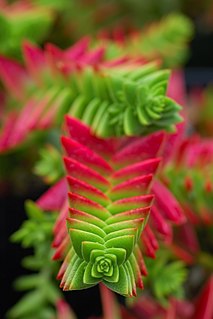
Crassula is a genus of succulent plants containing about 200 accepted species, including the popular jade plant. They are members of the stonecrop family (Crassulaceae) and are native to many parts of the globe, but cultivated varieties originate almost exclusively from species from the Eastern Cape of South Africa.

Juncus effusus, with the common names common rush or soft rush, is a perennial herbaceous flowering plant species in the rush family Juncaceae. In North America, the common name soft rush also refers to Juncus interior.

Maianthemum racemosum, the treacleberry, feathery false lily of the valley, false Solomon's seal, Solomon's plume or false spikenard, is a species of flowering plant native to North America. It is a common, widespread plant with numerous common names and synonyms, known from every US state except Hawaii, and from every Canadian province and territory, as well as from Mexico.
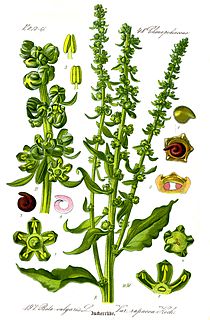
Beta is a genus in the flowering plant family Amaranthaceae. The best known member is the common beet, Beta vulgaris, but several other species are recognised. Almost all have common names containing the word "beet". Wild Beta species can be found throughout the Atlantic coast of Europe, the Mediterranean coastline, the Near East, and parts of Asia including India.

Acer tataricum, the Tatar maple or Tatarian maple, is a species of maple widespread across central and southeastern Europe and temperate Asia, from Austria and Turkey east as far as Japan and the Russian Far East. The species is named after the Tatar peoples of southern Russia; the tree's name is similarly commonly also misspelled "Tartar" or "Tartarian" in English.
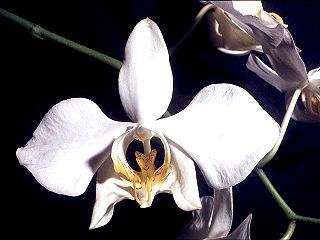
Phalaenopsis amabilis, commonly known as the moon orchid or moth orchid in India and as anggrek bulan in Indonesia, is a species of flowering plant in the orchid family Orchidaceae, native to the East Indies and Australia, and widely cultivated as a decorative houseplant. It is an epiphytic or lithophytic herb with long, thick roots, between two and eight thick, fleshy leaves with their bases hiding the stem and nearly flat, white, long-lasting flowers on a branching flowering stem with up to ten flowers on each branch.

Echinops sphaerocephalus, known by the common names glandular globe-thistle, great globe-thistle or pale globe-thistle, is a Eurasian species of globe-thistle belonging to the thistle tribe within the sunflower family.

Hakea decurrens, commonly known as bushy needlewood, is a species of shrub or small tree in the family Proteaceae.

Corymbium is a genus of flowering plants in the daisy family comprising nine species. It is the only genus in the subfamily Corymbioideae and the tribe Corymbieae. The species have leaves with parallel veins, strongly reminiscent of monocots, in a rosette and compounded inflorescences may be compact or loosely composed racemes, panicles or corymbs. Remarkable for species in the daisy family, each flower head contains just one, bisexual, mauve, pink or white disc floret within a sheath consisting of just two large involucral bracts. The species are all endemic to the Cape Floristic Region of South Africa, where they are known as plampers.

Pelargonium cucullatum is a hairy, upright, branching, perennial shrub, of 1–2 m (3.3–6.6 ft) high, that has been assigned to the cranesbill family. It sprouts new stems from the underground rootstock and becomes woody at its base. It has alternately set, sometimes slightly succulent leaves crowded near the top of the branches, with leaf stalks and flat to hood-shaped leaf blades, with a rounded broad triangular to kidney-shaped outline of about 4–5.5 cm long and 5–9 cm wide, often somewhat incised, the margin with irregular teeth. The white to purplish red, 5-merous, somewhat mirror symmetrical flowers grow in umbel-like clusters, and each contain mostly 7 fertile stamens and 3 infertile staminodes of different length. P. cucullatum has been cultivated as a garden ornamental and house plant since the 17th century. It has been used to breed many modern pelargonium hybrids, notably the Regal pelargoniums. It is called hooded-leaf pelargonium or herba althaea in English and wildemalva in Afrikaans.

Crassula capitella, is a perennial succulent plant native to southern Africa.

Crassula nudicaulis is a succulent plant native to South Africa, and Lesotho.

Schoenoplectus lacustris, the lakeshore bulrush or common club-rush, is a species of club-rush that grows in fresh water across Europe and some neighbouring areas.
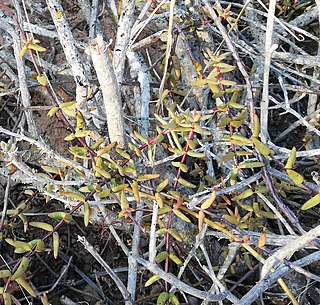
Crassula subaphylla is a succulent plant, widespread in the Karoo regions of South Africa and Namibia.
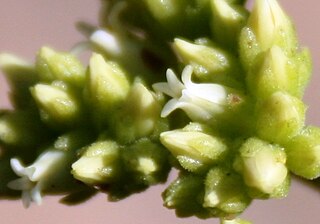
Crassula atropurpurea is a succulent plant, very common and widespread in the southern Karoo regions of South Africa and Namibia.

Crassula pubescens is a succulent plant, common and widespread in the southern Karoo regions of South Africa.

Scaevola plumieri is a species of plant in the family Goodeniaceae which grows on coastal dunes in the tropics and subtropics.

Crassula perfoliata is the type species of the genus Crassula, in the flowering plant family Crassulaceae, where it is placed in the subfamily Crassuloideae. It was first formally described by Linnaeus in 1753 as one of 10 species of Crassula. It is from South Africa.
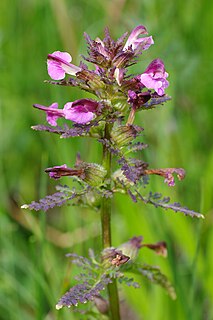
Pedicularis palustris, commonly known as marsh lousewort, is a plant species in the family Orobanchaceae. It is native to central and northern Europe and Asia where it grows in wetlands and boggy habitats. The International Union for Conservation of Nature has assessed its conservation status as being of least concern.























